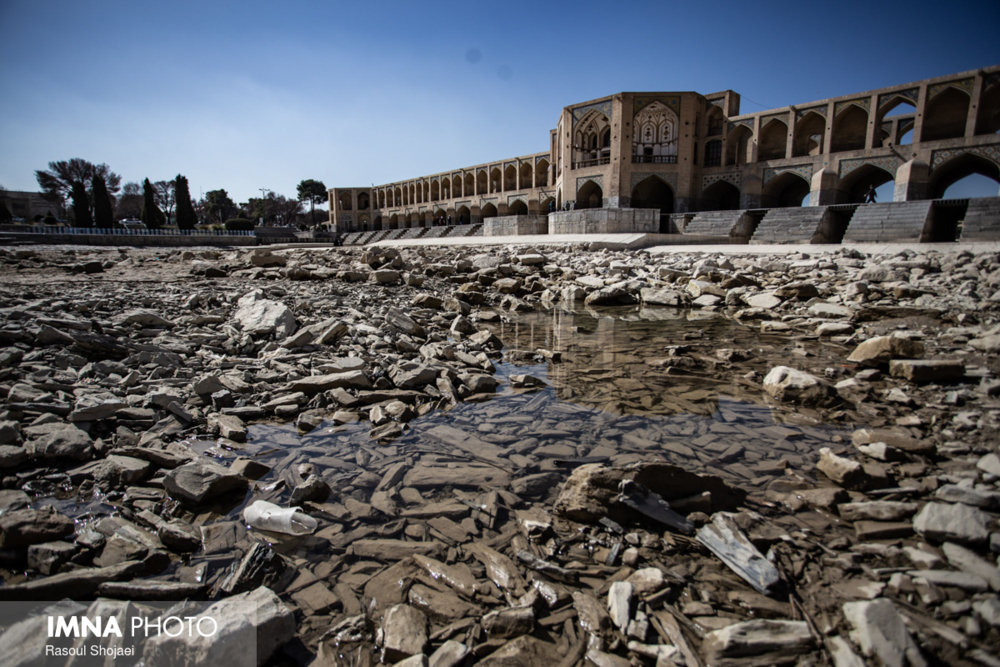Iran (IMNA) - Nowhere is the drought more visible than in Iran’s cultural capital, Isfahan, a historic city in the heart of the country. It is home to an iconic river, the Zayanderud, meaning the birth-giver river, that cuts it into parts.
The river has been temporarily drying for a couple of years due to a lack of rainfall and inadequate water management. Residents who used to wander along Isfahan's riverbanks and breathe in the fresh wind from the flowing water now shield their faces to protect themselves from the dust blowing from the dry riverbeds.
While some Iranian cities continue to witness water levels dropping in crucial rivers, lakes and reservoirs, a mixture of climate change and poor water management policies are causing similar events in Isfahan.

Conditions are getting worse as a result of climate change as higher temperatures hasten evaporation, thirsty plants absorb more moisture, and less snowfall in the winter reduces the amount of fresh water available for irrigation in the summer. Isfahan isn’t alone in the crisis, with drought conditions also reported in some central and southern Iranian cities.
As bodies of water continue to dry up, a two-pronged strategy involving climate change mitigation and more sophisticated water management regulations will be essential. However, there has already been so much damage that not even radical changes will have an immediate impact on easing the strain on water levels.
Threats to environment
Animals and plants near the Zayanderud river are already bearing the burden of the dry-up. While droughts are a natural part of the climatic condition of Isfahan, and its river animals have also adapted, they can’t adjust to continual low-level water and they certainly can’t survive long-term drying.

Every time the river dries up, all fish and other river animals perish since there is no water flowing in and they are confined and immobile upstream and downstream. The oxygen level continues to drop as the water level drops.
Dust storms would also be a major issue if the river totally dried up because of the lingering heavy metals and poisonous compounds that have been trapped in the sediment for many years.
Impacts of drought on agriculture
Widespread regions downstream of the river have also been relatively dry, which has significantly increased crop water needs and use.
The human-caused climate crisis is fueling extreme weather across Iran, which isn’t just impacting rivers but also the people who rely on them. Most people in the country depend on rivers in some way, whether for drinking water, to irrigate food, for energy, or to ship goods.
These droughts have the greatest impact on Isfahani farmers and herders, putting them in a difficult position and putting many rural people at risk of being displaced.
Many farmers are coping with difficult economic and security circumstances while also having to adjust to new realities brought on by climate change. Farmers in eastern Isfahan might run into problems as a result of this.

They'll probably have less water in the future, especially if the region becomes drier due to climate change. This can lead to a decrease in the availability of local vegetables and an increase in their price for customers. The region's economy and the numerous farming families, some of which have been producing food here for more than a century, might be harmed by the continued drought.
Authorities periodically open the floodgates of the upstream dam to water wheat fields east of Isfahan, much to the joy of hundreds who rapidly swarm to the river.
This occurs in mid-May, when residents and visitors flock to the river to take selfies and record the fleeting vistas with their eyes.
Families drink tea and picnic on the banks, under the cover of the trees. Some people walk, while others pedal swan-shaped boats that have been sitting in the dust for some time.

If we don't figure out an approach to bring back more of the low and medium flows to this area, we risk experiencing Isfahan's biggest environmental catastrophe. Some revival programs have made progress in returning certain flows to the Zayanderud River.
Typically, management plans are developed in light of a river's historical behavior. However, we must consider the complete range of possible river flows since, despite what may appear to be the case, this is not how things have always been and will continue to be.


Your Comment